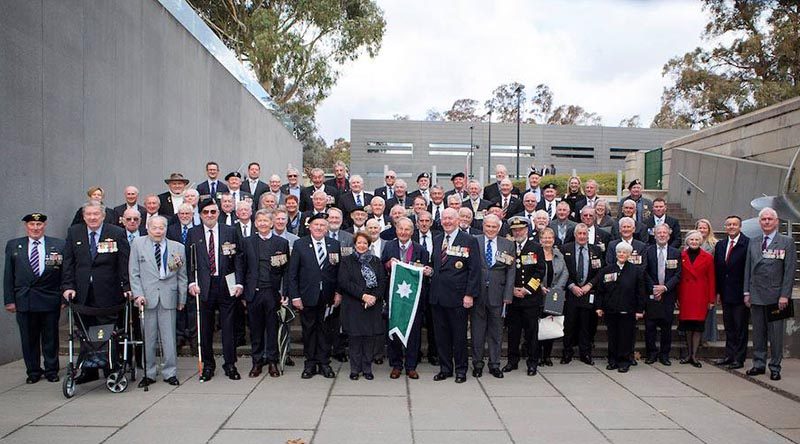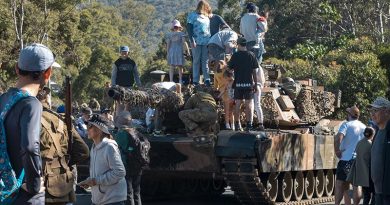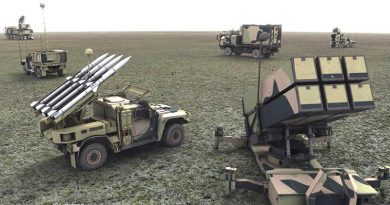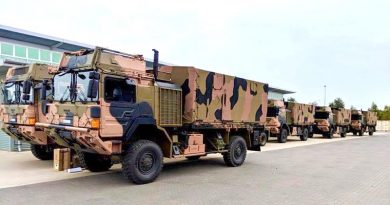RANHFV Unit Citation for Gallantry presented by GG
Share the post "RANHFV Unit Citation for Gallantry presented by GG"

The outstanding service of the Royal Australian Navy’s Helicopter Flight Vietnam (RANHFV) was today recognised with the presentation of the Unit Citation for Gallantry at a ceremony conducted by the Governor-General Sir Peter Cosgrove and former Chief of Navy Vice Admiral Tim Barrett.
CAPTION: Members of Helicopter Flight Vietnam at the Australian War Memorial, Canberra, after the presentation of their Unit Citation for Gallantry with guests including Governor General Sir Peter Cosgrove, Minister for Veterans’ Affairs Darren Chester and former CN Vice Admiral Tim Barrett. RAN photo.
The ubiquitous Bell UH-1 Iroquois helicopter is still arguably the most instantly recognisable symbol of the Vietnam War.
Images of the ‘helicopter war’ feature prominently in books, films and documentaries.
Not so widely known is the role that was played by personnel of the RAN’s Fleet Air Arm (FAA), in a war that was heavily dependent on tactical air movement of combat troops, supplies and equipment in what were eventually called air-mobile operations.
Between 1967 and 1971 the Royal Australian Navy Helicopter Flight Vietnam (RANHFV), was fully integrated with the US Army 135th Assault Helicopter Company (AHC) flying Iroquois helicopters in both the utility and gun-ship configurations.
As a result of this unique relationship between the RAN and the US Army, the unit was officially designated ‘EMU’, for Experimental Military Unit. This was fitting, given that the EMU is a native Australian bird, yet amusing at the same time because of the Emu’s inability to fly. The unit later designed its own unique badge and adopted the unofficial motto ‘get the bloody job done’. In keeping with Australian Naval tradition many of the aviators also grew beards to distinguish themselves as sailors in a predominantly army environment.
The 135th AHC was initially based at Vung Tau and comprised two troop lift platoons, each with eleven UH-1Ds, a gun-ship platoon with eight UH-1Cs, a maintenance platoon with a single UH-1D and a headquarters platoon. Six of the gun-ships were equipped with mini guns, rockets and machine guns. The remaining two were fitted with the XM-5 40mm grenade-launcher system, rockets and machine guns.
The role of 135th AHC was to provide tactical air movement of combat troops, supplies and equipment in air-mobile operations. This included augmentation of army medical services, search and rescue and the provision of a command and control aircraft capability.
Minister for Defence Personnel Darren Chester said the outstanding service of the personnel of RANHFV was worthy of the Citation and paid tribute to the members and their descendants, thanking them for their courage, dedication and service.
“I am proud to be part of today’s ceremony to acknowledge all those who served and it is appropriate that on our national day of remembrance we recognise the contribution of the RANHFV,” Mr Chester said.
Deployed to South Vietnam between October 1967 and June 1971, the 196 officers and sailors of RANHV were integrated with the US Army 135th Assault Helicopter Company (AHC).
With AHC they flew helicopters in both utility and gunship configurations averaging 750 flying hours per month.
Sadly, five Navy personnel died while serving with the RANHFV and 22 were wounded in action.
Mr Chester said the motto of RANHFV “get the bloody job done” personified the nature of the Australian service personnel both then and today.
“This attitude is evident in service men and women I meet today in the Australian Defence Force including the Navy’s modern Fleet Air Arm.
“Today we acknowledge the bravery and courage shown by the members of Helicopter Flight Vietnam, and the critical role families and loved ones played in these events of our past,” Mr Chester said.
“Your bravery during the battle, your care and support upon their return, your never-fading memories of those who didn’t return and those who did but are not longer with us, will never be forgotten.
“The extraordinary courage displayed by Royal Australian Navy personnel in Vietnam in adapting to offensive helicopter operations in the field in both a joint and coalition force environment was unique in our history at the time and a forerunner to the adaptability and attitude of the Fleet Air Arm today.”
.
.
.
.
.
.

.
.
Share the post "RANHFV Unit Citation for Gallantry presented by GG"





